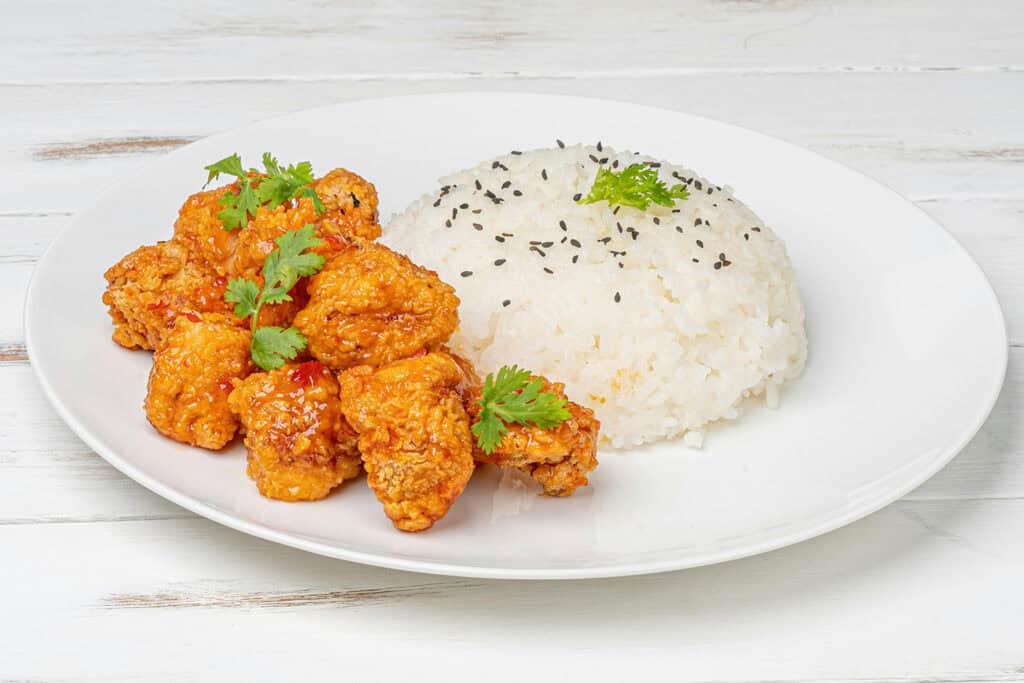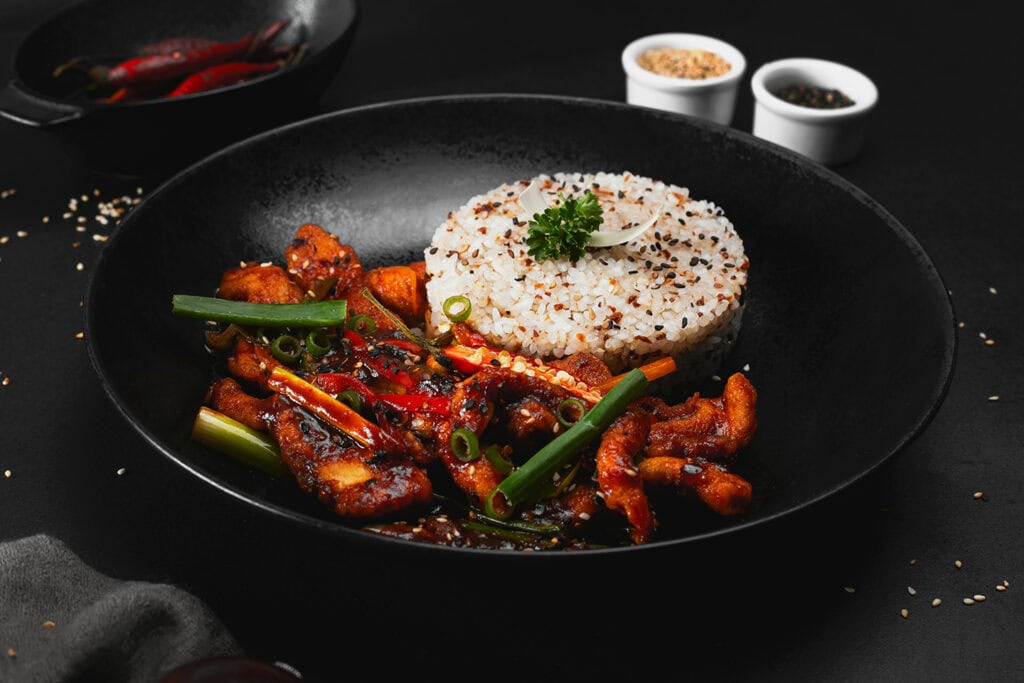
Looking for a straightforward way to support your fitness and health goals? The chicken and rice diet offers a balanced approach that’s affordable, simple to prepare, and full of nutrition.
With benefits like sustained energy and muscle recovery support, this diet is versatile and easily adaptable. Plus, you’ll see how adding options like diet green tea can enhance your overall health routine.
In this article, you’ll discover 9 important insight, 10 practical Variations, nutritional benefits, and tips to keep your meals varied and enjoyable.
After reading this article, you’ll understand how the chicken and rice diet can support your wellness goals with balanced nutrition and practical benefits.
Ready to fuel your body with a simple, effective plan? Read on to learn how this diet can benefit you!
- 1. Why Choose a Chicken and Rice Diet?
- 2. Nutritional Benefits
- 3. How to Prepare Chicken and Rice
- 4. Variations of the Chicken and Rice Diet
- 5. Benefits for Weight Loss and Muscle Building
- 6. Tips for a Healthy Chicken and Rice Diet
- 7. Popular Chicken and Rice Diet Challenges
- 8. Including Other Ingredients
- 9. Cons of the Chicken and Rice Diet
- Chicken and Rice Diet: A Recap
1. Why Choose a Chicken and Rice Diet?
Choosing a chicken and rice diet can support wellness and healthy eating habits. This simple combination offers balanced nutrition. Chicken is rich in lean proteins, essential for muscle growth and weight loss.
Rice, whether white or brown, provides complex carbohydrates and energy. Brown rice is more nutrient-dense, adding fiber and vitamins. Together, chicken and rice create a good diet plan that helps manage calorie intake. Including these nutrient-dense foods promotes weight loss and balanced nutrition.
This diet also encourages healthy, filling meals without processed ingredients. It is easy to prepare and can be tailored with vegetables for extra essential nutrients. Making chicken and rice a staple can support better eating and lasting healthy habits.
Here are the benefits of the chicken and rice diet:
- Affordability: Chicken and rice are budget-friendly staples.
- Versatility: Adaptable to various spices and recipes.
- Digestibility: Gentle on the stomach and easy to digest.
- Simple Meal Prep: Quick and straightforward to cook.
- Low Allergen Risk: Less likely to trigger common food allergies.
- Low in Fat: Naturally low in fat, supporting a lean diet.
- Sustained Energy: Provides long-lasting energy due to complex carbs.
- Portion Control: Easy to measure for balanced servings.
- Supports Muscle Recovery: Protein aids post-workout recovery.
- Gluten-Free: Suitable for gluten-sensitive individuals.
- Hydration: Combined with broths, helps maintain hydration.
2. Nutritional Benefits

Chicken: Chicken is packed with protein, which helps build and maintain muscles. It also contains essential vitamins and minerals such as vitamin B6, niacin, and selenium. These nutrients support metabolism and immune health.
Rice: White rice is a source of simple carbohydrates, providing quick energy. Brown rice, on the other hand, is richer in fiber, vitamins, and minerals. It helps with digestion and keeps you fuller for longer.
Combining the Two: Together, chicken and rice create a balanced meal. The protein from the chicken and the carbohydrates from the rice give your body energy and nutrients.
See also Why Is Diet Important? 8 Key Benefits for a Healthier You
3. How to Prepare Chicken and Rice
Making chicken and rice can be simple and quick. Here’s a basic recipe to start with:
Ingredients:
- 1 boneless, skinless chicken breast
- 1 cup of rice (white or brown)
- Salt and pepper to taste
- 1 tablespoon of olive oil
- Optional: vegetables like carrots, broccoli, or spinach
Instructions:
- Season the chicken with salt and pepper.
- Heat olive oil in a pan and cook the chicken for about 5-7 minutes on each side or until fully cooked.
- While the chicken cooks, prepare the rice according to the package instructions.
- Serve the chicken over the rice. Add steamed vegetables for more nutrients.
Tip: Use herbs like thyme, rosemary, or paprika to add more flavor without extra calories.
4. Variations of the Chicken and Rice Diet
1. Chicken Stir-Fry: Add bell peppers, onions, and soy sauce to your chicken and rice. This adds color and flavor.
2. Lemon Herb Chicken and Rice: Marinate the chicken with lemon juice, garlic, and herbs before cooking. Serve with rice and a sprinkle of fresh parsley.
3. Spicy Chicken and Rice: Add chili flakes, cayenne pepper, or hot sauce to the chicken for a spicy kick. Serve with rice and a side of cucumber salad to cool it down.
4. Chicken and Rice Soup: Cook the chicken and rice in a pot with chicken broth, carrots, and celery for a comforting soup. Add garlic and black pepper for extra taste.
5. Curry Chicken and Rice: Simmer chicken in a sauce made with curry powder, coconut milk, and tomatoes. Serve over rice for a delicious and fragrant meal.
6. Chicken Fried Rice: Sauté cooked rice with diced chicken, eggs, peas, and carrots. Add a splash of soy sauce for flavor.
7. Garlic Butter Chicken and Rice: Cook chicken in a garlic butter sauce and serve over rice. Top with steamed broccoli for a nutritious side.
8. Teriyaki Chicken and Rice: Marinate chicken in teriyaki sauce and grill or pan-fry. Serve with rice and steamed edamame for a complete meal.
9. Mediterranean Chicken and Rice: Season chicken with oregano, lemon, and olive oil. Serve over rice with diced tomatoes, olives, and feta cheese.
10. BBQ Chicken and Rice Bowl: Top rice with shredded BBQ chicken, corn, and black beans. Add a dollop of Greek yogurt or avocado for a creamy finish.
5. Benefits for Weight Loss and Muscle Building
The chicken and rice diet is known for supporting both weight loss and muscle building. Here’s why:
Weight Loss:
- High protein helps reduce appetite.
- Brown rice adds fiber, which keeps you full.
- Lean chicken keeps calories low but nutrition high.
Muscle Building:
- Protein from chicken helps repair and grow muscles.
- Carbs from rice provide energy for workouts.
- Adding healthy fats, like avocado, can provide extra fuel for training.
Example Plan:
For weight loss, aim for a smaller portion of rice and add more vegetables. For muscle gain, keep the chicken amount high and increase the rice portion for more carbs.
6. Tips for a Healthy Chicken and Rice Diet

- Choose Lean Cuts: Use skinless chicken breast to reduce fat.
- Opt for Brown Rice: Provides more fiber and nutrients than white rice.
- Balance with Veggies: Add vegetables for vitamins and minerals.
- Limit Seasonings: Avoid excessive salt and high-sodium sauces.
- Cook with Healthy Oils: Use olive or avocado oil sparingly.
- Control Portions: Stick to balanced servings to manage calorie intake.
- Include Spices: Use natural herbs for flavor without extra calories.
- Hydrate Well: Drink enough water alongside your meals.
- Vary the Recipes: Prevent monotony by trying different cooking styles.
- Monitor Nutrient Intake: Ensure you’re getting enough protein, carbs, and healthy fats.
7. Popular Chicken and Rice Diet Challenges
Some people take on chicken and rice challenges to meet specific fitness or health goals. Here’s how they work:
30-Day Chicken and Rice Challenge:
- Eat variations of chicken and rice for 30 days.
- Include vegetables, herbs, and spices to make meals interesting.
- Drink plenty of water and stay active.
Benefits:
- Simple and easy to follow.
- High protein helps build muscle and burn fat.
Drawbacks:
- Repeating meals can become boring.
- It may lack certain nutrients if not balanced with other foods.
8. Including Other Ingredients

To make sure you get all the nutrients you need, consider adding these to your chicken and rice meals:
1. Healthy Fats:
- Add avocado slices or a sprinkle of chia seeds.
- Use a small amount of olive oil for cooking.
2. More Protein:
- Include beans or lentils for extra protein and fiber.
3. Spices and Herbs:
- Use cumin, turmeric, or garlic powder for added health benefits.
4. Sauces:
- Be careful with sauces high in sugar or unhealthy fats. Choose light soy sauce, lemon juice, or homemade tomato sauce.
9. Cons of the Chicken and Rice Diet

- Limited Nutrient Variety: The diet may lack essential vitamins and minerals found in diverse foods.
- Monotonous Meals: Eating the same meals can lead to boredom and reduced motivation.
- Risk of Overeating: Without proper portion control, calorie intake can easily increase.
- Low in Healthy Fats: The diet often misses the healthy fats needed for overall wellness.
- Nutritional Imbalance: A narrow food selection can lead to nutrient gaps over time.
- Potential for Bland Flavor: The simplicity of ingredients may result in uninteresting meals.
- Lack of Dietary Fiber (with white rice): White rice has less fiber, which may impact digestion.
- Possible Deficiency in Vitamins and Minerals: Limited food options can reduce overall nutrient intake.
- Overreliance on One Protein Source: Depending mainly on chicken limits protein variety.
- Requires Careful Portion Control: To avoid weight gain, serving sizes must be monitored.
See also Wellness Vision Board: 7 Key Areas to Focus On for Holistic Well-Being
Chicken and Rice Diet: A Recap
To wrap up the “Chicken and Rice Diet,” it’s vital to keep balance in mind. Eating chicken and rice can be a solid start for weight loss and overall health. These foods offer lean proteins and energy-rich carbohydrates.
But to boost the nutritional value, add variety. Include healthy snacks like fruits and vegetables. Watch portion control to avoid overeating and ensure balanced meals. Recipes like teriyaki chicken with brown rice or other rice diet recipes can keep things flavorful and nutritious.
Avoid sticking only to white rice and chicken; incorporate other healthy foods for optimal health. Limit unhealthy foods and pair your meals with Diet Sprite or water to stay hydrated. This helps maintain weight loss and overall wellness.


